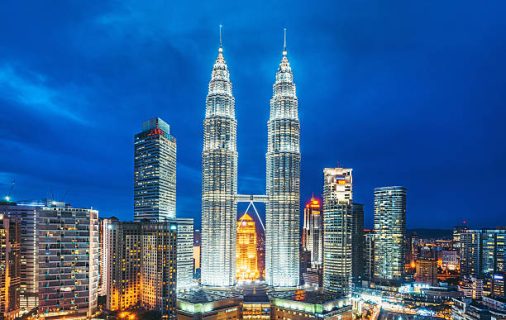Asia, a continent of diverse cultures and landscapes, is also a canvas for architectural innovation. The evolution of high-rise design in Asia weaves a narrative of progress, showcasing the fusion of tradition and modernity, and reflecting the continent’s urban transformation.
This journey unfolds a captivating tale of architectural brilliance. This is from the historical foundations of towering structures to the sky-piercing landmarks of today.
Which was the first tower in Asia in the early ages?
One of the earliest high-rise structures in Asia is believed to be the Great Stupa of Sanchi in India. While it might not fit the traditional definition of a tower, it is an ancient architectural marvel that dates back to the Mauryan period, around the 3rd century BCE.
The history of high-rise buildings in Asia traces back to ancient civilisations that crafted monumental structures fusing artistry with functionality. China’s Great Pagoda, an architectural wonder of the Tang Dynasty, stands as an early testament to the concept of height.
Similarly, India’s Qutub Minar, a UNESCO World Heritage Site, narrates the story of the Delhi Sultanate’s dominance while showcasing a mastery of intricate stonework. These historical wonders set the stage for Asia’s future vertical aspirations.
As centuries unfolded, cultures across Asia experimented with height, culminating in iconic structures such as Cambodia’s Angkor Wat, a fusion of spirituality and architecture, and Japan’s towering pagodas, exemplifying elegance and balance. These early experiments laid the foundation for the evolution of high-rise design.
The evolution of high-rise design in Asia

The evolution of high-rise design in Asia is a testament to human innovation and technological advancement. The transition from traditional materials to cutting-edge construction methods has propelled the creation of skyscrapers that defy gravity.
Introducing steel frames, reinforced concrete, and curtain wall systems revolutionised high-rise architecture. This has allowed architects to push the boundaries of height and design.
The Petronas Towers in Kuala Lumpur, once the tallest buildings in the world, stand as a prime example of Asia’s architectural prowess. Designed with Islamic motifs and a postmodern aesthetic, these twin towers seamlessly blend cultural identity with modern engineering.
The Taipei 101 in Taiwan redefined disaster resistance by incorporating a tuned mass damper, with its pagoda-inspired design paying homage to the country’s rich heritage. The evolution of high-rise design in Asia reflects engineering achievements and highlights the cultural narratives that shape these structures.
Which are the tallest structures in Asia?
The Burj Khalifa in Dubai, United Arab Emirates, is the tallest structure in Asia and the world. Its impressive height of over 828 meters (2,722 feet) and 163 floors make it an iconic symbol of modern engineering and architectural innovation.
The landscape of Asia is punctuated with towering structures that capture the essence of urban progress. As a result, the Top 10 Tallest Structures in Asia offer a mesmerising journey through architectural diversity. The Shanghai Tower, with its innovative twisting form, speaks to China’s emergence as a global powerhouse.
The Abraj Al Bait Clock Tower in Mecca, a spiritual and technological marvel, symbolises Saudi Arabia’s embrace of modernity. Meanwhile, the Lotte World Tower in Seoul, South Korea, embodies the nation’s creative spirit and technological excellence.
The tallest building in Southeast Asia
Southeast Asia’s rapid urbanisation is evident in its cityscapes adorned with vertical marvels. The Tallest Building in Southeast Asia, the Merdeka 118, remains an iconic symbol of Malaysia’s ambition and progress.
Meanwhile, the MahaNakhon in Bangkok, Thailand, boasts a pixelated, daring, and dynamic design. The Philippines’ Grand Hyatt Manila Residences showcases architectural elegance amidst a thriving metropolis. These structures redefine Southeast Asia’s skyline while preserving cultural heritage.
The tallest tower in the world is in Asia

Dubai’s Burj Khalifa stands as an architectural wonder, embodying the heights of human achievement and ambition. As the Tallest Tower in the World, it reaches towards the heavens, a testament to Dubai’s global aspirations. Its sleek design, advanced engineering, and cultural influences from the region create an awe-inspiring symbol of modernity.
Merdeka 118, the second tallest building in the world
In Kuala Lumpur, the Merdeka 118 project is shaping up to be a defining landmark in Asia’s architectural landscape. Being the second tallest building in the world, it reflects Malaysia’s journey towards becoming a global player. This towering masterpiece embodies innovation, sustainability, and progress, resonating with Asia’s dynamic spirit.
READ ALSO: The evolution of high-rise design in Europe
The evolution of high-rise design in Asia is a testament to human creativity, engineering prowess, and the fusion of tradition with innovation. From the historical echoes of towering monuments to the modern skyline-defining giants, Asia’s architectural journey is a reflection of the continent’s progress.

